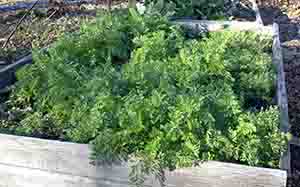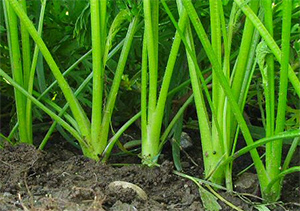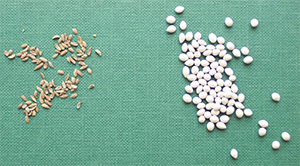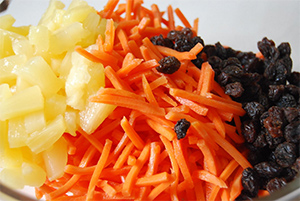
by Douglas Stevenson
The heavy, clay soil in our area is not conducive to carrots, which turn out short, stubby and twisted as they struggle to penetrate the dirt.
To compensate, I have constructed raised beds out of naturally rot resistant cedar boards I purchased from a local Amish mill. The beds are approximately 3 feet by 5 feet, the same width and length of a roll of steel hardware cloth purchased from a hardware store.
I placed hardware cloth on the bottom of each raised bed to prevent intrusion from carrot munching voles, the larger, veggie eating cousin of the mole.
I filled each bed with 1/3 peat moss, 1/3 compost, a 5 gallon bucket of sand, topping it off with regular dirt and mixed it all together. The beds are about a foot deep. I find I have to add more compost and peat moss each year as the mixture settles in order to maintain the depth.

I also threw in a few shovel scoops of vermiculite, a substance often used in potting soils to aerate the soil and help it hold on to moisture.
Carrots should be spaced about 3 inches apart, a task that is made much easier by purchasing clay coated seeds.

Individual carrot seeds are tiny and it can be nearly impossible to keep from planting them too thick when pouring them from the seed packet. You can purchase clay coated or pelleted seeds from a catalog called Johnny’s. Although you’ll spend a little more, the ease of planting and end results are worth it.
I tried planting from uncoated seeds, and what came up was a carrot hedge! I followed the suggestion of using scissors to cut away the green tops of the extra seedlings to get the proper spacing, but found it difficult to tell when I was down to a single plant. The multiple carrots wrapped around each other as they grew and eventually I got a few that were large enough to use.

The properly spaced, clay coated seeds produced carrots that were beautiful, long, fat and sweet. You can plant carrots in both the spring and fall, but the ones that mature during cooler temperatures of fall and winter are by far the sweetest!
Here in Tennessee we can plant in late August or early September, The carrots stay in the beds with the plants uncovered throughout the winter months, even with temperatures down into the low 20’s! I simply harvest as needed.
It has been really nice to go out each evening and pull up a carrot, adding it to our salad or a stir fry. Fresh is best!
Vegan Carrot Salad
- 3 cups grated carrots
- 1/2 cup raisins
- 1/2 cup vegan mayonnaise – We prefer Veganaise made from grape seed oil.
- 1/2 cup diced pineapple or pineapple chunks
Grate the carrots by hand or use a food processor. Drain the pineapple juice and set aside to use in a smoothie later. Combine all the ingredients in a large bowl and then chill for at least 30 minutes to allow the flavors to merge. A great way to get more raw carrots into your kids!




